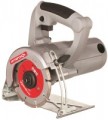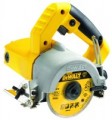Power
Rated motor power of the electric tile cutter. The more powerful the engine — the more force it can give to the cutting tool, the higher the rotation speed and disc diameter can be. Accordingly, a more
powerful tool is better suited for larger jobs and hard and/or thick materials. On the other hand, high power significantly affects the price, dimensions and weight of the tool, despite the fact that there is not always a real need for it.
In light of all this, it is necessary to choose a tile cutter in terms of power, taking into account the specifics of the intended use. So, in the case of a hand tool for simple household work, a power of 700 – 800 W is enough, more solid indicators may be required mainly for professional use. But in stationary units, where compactness does not really matter, you can not save on power — especially since such devices are usually used where performance is important.
Disc diameter
The nominal diameter of the cutting disc for which the electric tile cutter is designed. A disk of a larger diameter will simply not fit into the seat; but the use of smaller nozzles in some cases is allowed (but not recommended).
The depth of cut depends primarily on the diameter of the disc (see below). So, with ordinary tiles, having a thickness of up to 1.5 cm, almost any disc, even the smallest one, will cope; but for thicker materials (for example, paving slabs) and the appropriate tool will be needed. However it is worth noting that with the same diameter of the disc, the thickness of the cut may be different.
Also, the size of the cutting tool allows you to generally evaluate the class of the tool: the larger the disc, the more powerful and performant the tile cutter, usually.
Cutting depth
The greatest depth to which the tool can cut through the material being processed, in other words, the maximum thickness of the tile that the tile cutter is guaranteed to be able to cut.
It is worth choosing a tool for this parameter taking into account the thickness of the material with which to work, plus some margin “just in case”. But this margin should not be too large: for a
deep cut, large discs and high power are required, which accordingly affects the price, weight and dimensions of the tool.
Water cooling
The presence in the design of the electric tile cutter
of a system for supplying water to the disc.
Water supplied directly to the cutting point plays several roles: it cools the cutter and tile, reduces friction at the point of contact, and also precipitates the dust generated during operation. This reduces the risk of cracks and chips, provides a neat and even cut, allows you to cut thin strips of material, and also has a positive effect on the life of the blade and the entire tool. The supply of water, usually, is in its own tank installed on the tile cutter.
Noise level
The average noise level produced by the tile cutter during operation. Actual figures may differ from those claimed in any direction, depending on the specific material, speed of work, wear of the cutting blade, etc. However, in general, according to this indicator, it is quite possible to evaluate the loudness of the unit.
The lower the noise level, the more comfortable the work with the tile cutter, the lower the fatigue. The quietest of modern instruments give out about 60 dB — this is the level of a loud conversation at a distance of about 1 m; in the most noisy, the volume exceeds 100 dB (sound background in an industrial workshop).

